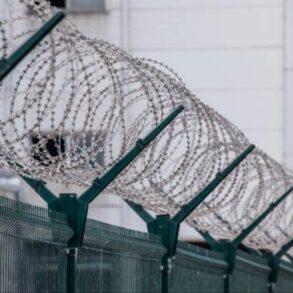Internet Explorer 11 is not supported
For optimal browsing, we recommend Chrome, Firefox or Safari browsers.
U.S. prisons are dangerous for corrections staff and incarcerated people alike and recidivism rates are high. Can a Scandinavian-inspired culture shift help?
SVT/John Stark
- A Pennsylvania prison is testing a new approach that gives incarcerated people more autonomy and encourages corrections staff to converse with those they oversee. The goals: make conditions in prison safer and better prepare incarcerated people to return to society.
- The project is inspired by Scandinavian prisons’ focus on rehabilitation. But there are practical and cultural challenges to bringing a Scandinavian-inspired approach to the U.S.
- It’s too soon to draw definitive conclusions, but the model appears to have brought down violence at the Pennsylvania unit.
There are a multitude of reasons why prisons are dangerous places. This leads to risk not only for prisoners but correctional staff. A few years ago, officials from a state prison in Chester, Pa., decided to look for inspiration somewhere far outside the U.S. prison system. They visited prisons and training academies in Norway, Sweden and Denmark. In Norway, recidivism has fallen significantly since the 1980s, when the country shifted its approach from punishment to rehabilitation and reintegration.
Three years ago, State Correctional Institution — Chester (SCI Chester) opened a “Little Scandinavia” housing unit. The unit gives people incarcerated there more freedoms and responsibilities, a physical space redesigned to feel more like normal life and an environment that encourages respectful relationship-building among incarcerated people and between incarcerated people and staff.
Changes aimed to make the unit stop feeling like a highly institutionalized setting and more like a group house. Residents would get more freedoms and handle more of the tasks they’d need to do in daily life on the outside. In SCI Chester’s unit, incarcerated residents got a cell to themselves, rather than sharing. The unit was given a full kitchen where residents could cook their own meals and a washer-dryer for doing their own laundry. The team swapped out metal and plastic furniture for furniture made with wood and fabric and added sound-dampening panels, planters and other features to encourage incarcerated people to spend time in the public space and socialize. To further build community, those already living in the unit mentor new people coming in.
SVT/John Stark
The goal was to prepare incarcerated people for life outside, reduce stress on everyone and create security through personal connections rather than tight containment. Staff are less likely to be attacked by incarcerated people who see them as a person, rather than as just an instrument of the larger carceral machine, says Jordan Hyatt, a criminologist at Drexel University who co-leads research studying the reform efforts at the Little Scandinavia unit and the impacts on officers and those incarcerated. Chester’s reform project is a collaboration among the Pennsylvania Department of Corrections, Swedish and Norwegian correctional services and academic researchers from Drexel University and the University of Oslo.
Given the Chester unit has only been operating since May 2022 and that it houses a relatively small group, researchers caution that it’s too early to draw strong conclusions. But preliminary data is promising. People incarcerated in the unit have reported feeling safer and, since the unit opened in May 2022, there’s been only one incident that the prison categorized as “violent.” That specific incident was an argument or confrontation, rather than a severe assault, Hyatt says. That rate of incidents is “much lower than you would expect in a similarly situated housing unit that had a different culture and climate.”
Turning prisons into Scandinavian-style facilities isn’t going to happen everywhere. It’s expensive to physically renovate prisons to make them feel more communal than institutional. And, at a moment when many policymakers are wanting to crack down on crime, some oppose spending more money to improve conditions for those in prison.
Still, other states such as California, Washington, Oregon, North Dakota and Connecticut have been exploring Norway-inspired approaches.
“Political and prison leaders, prison staff and community leaders are increasingly recognizing the toll that these institutions have on the health and wellbeing of staff, people who are incarcerated, and their families,” says Brie Williams, who directs a program at the University of California, San Francisco that works to improve the culture and public health outcomes in prisons.
Difficult Conditions
U.S. prisons are notoriously dangerous, with incarcerated people and officers facing risks of injury and death. And prisons aren’t reliably preparing people for a smooth return to society, either. A Bureau of Justice Statistics study of 24 states found that 82 percent of people released from state prisons in 2008 were re-arrested at least once in the following decade and 43 percent were arrested within a year of release.
Incarcerated individuals face a heightened risk of being killed — 2.5 times greater than the U.S. population as a whole. Prison staff also face serious risk. A 2017 survey of correctional officers in California found that 29 percent reported suffering serious injuries at work, while 85 percent witnessed someone killed or seriously injured. About half of the officers said they rarely felt safe at work.
When SCI Chester redesigned one of its units, the plan was never to “copy-paste” Scandinavian approaches, but rather for officers to draw inspiration and see what they could adapt for home, says Dr. Synøve Andersen, associate professor at the University of Oslo who co-leads the Scandinavian Prison Project research project with Hyatt.
Frontline officers — not researchers — decided the approaches they wanted to adopt. Officers wanted a prison environment that would promote community and re-create more of normal life. U.S. prisons typically look askance at frontline staff speaking with incarcerated people for longer than a minute, and officers needed to get special permission to do this on their Little Scandinavia unit. Officers were trained in areas such as conflict mediation that are traditionally reserved for other personnel.
“Something that would get them in trouble on another housing unit is fundamental to the way this unit runs,” Hyatt says.
Staff were no longer going to focus only on containing people but on preparing them to become someone’s future neighbor and functioning members of outside society, said Julie James, vice president of criminal justice policy at Arnold Ventures, a foundation that supports criminal justice research and provided some of the financing for the Scandinavian Prison Project.
Some Obstacles Remain
This is not an approach that will be adopted everywhere. Scandinavian-style incarceration requires additional staff training and education; SCI Chester’s Little Scandinavia unit features a higher ratio of staff to incarcerated people. Meanwhile, the U.S. is already experiencing an unprecedented correctional staffing shortage that has prompted many prisons to lower both educational and age requirements for new hires.
It’s also expensive to physically renovate U.S. prisons to make them feel more communal than institutional. Some units do try less intensive changes, like new furniture and letting incarcerated residents pick art for the walls.
At SCI Chester, staff have volunteered to work in this unit and incarcerated residents were selected through a lottery. The population in the unit was chosen to reflect the larger facility, including the same proportion of people serving longer or shorter sentences.
Not all the new ideas made it. Officers originally proposed having a small, on-site grocery store where prisoners could purchase fresh produce for cooking. That idea instead turned into the unit having a delivery service where residents could order groceries they’d receive once the items had cleared security. A proposal to let incarcerated people wear their own street clothes was scrapped, with prisoners and officers instead getting new uniforms.
Still, the closer relationships between officers and residents benefit both and remind everyone of each other’s humanity, said SCI Chester Superintendent Gina Clark. “For the officers, they see the dignity and humanity in the residents, not just a DOC [Department of Corrections] number,” Clark said. “For the residents, they understand the ‘why’ behind certain rules and they get a different perspective on how their actions can negatively or positively impact others.”
Never miss a story with Governing’s Daily newsletter.
This post was originally published on this site be sure to check out more of their content.








